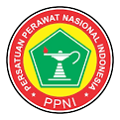Hubungan Rasio APO-B/APOA-I dengan Index Massa Tubuh
DOI:
https://doi.org/10.26630/jk.v13i1.2686Keywords:
Body mass index, Obesity, Ratio Apo-B/ApoC-II.Abstract
Body Mass Index (BMI) is a simple way to monitor weight. Overweight as a result of excessive body fat accumulation which is characterized by a decrease in HDL (High-Density Lipoprotein), namely the atherogenic side represented by levels of Apolipoprotein AI (ApoA-I), increased triglycerides (TG), VLDL (Very Low-Density Lipoprotein). ), LDL (Low-Density Lipoprotein), and Total Cholesterol which is the anti-atherogenic side represented by the levels of Apolipoprotein B (Apo-B). If we measure both Apo-B and ApoA-I and express them as the Apo-B/ApoA-I ratio, we get a strong marker of cardiovascular risk. By combining the two markers in the ratio, we get synergies and increase predictive power. This study aims to analyze the levels of Apo-B, ApoA-I, and the ratio of Apo-B/ApoA-I to BMI. An experimental study with a cross-sectional design using 72 subjects during April 2021. Apo-B and ApoA-I were examined using the Cobas c311/501 instrument with the immunoturbidimetric test method. The results of this study showed a significant relationship between Apo-B levels and BMI, while ApoA-I levels and Apo-B/ApoA-I ratios did not have a significant relationship. In conclusion, there is no relationship between BMI and the ApoB/ApoA-I ratio in male and female subjects.
References
Afandi, M. R., & Marpaung, F. R. (2019). Correlation Between Apoprotein B/apoprotein Ai Ratio with Homa Ir Value (Homeostatic Model Assesment Insulin Resistance) in Type 2 Diabetes Mellitus. Journal of Vocational Health Studies, 3(2), 78-82. https://doi.org/10.20473/jvhs.V3.I2.2019.78-82
Arief, R. Q. (2012). Obesitas dan Profil Lipid pada Mahasiswa Baru Angkatan 2012-2013 Universitas Hasanuddin. [Tesis]. Makassar: Program Studi Kesehatan Masyarakat, Universitas Hasanuddin.
Borén, J., & Williams, K. J. (2016). The central role of arterial retention of cholesterolrich apolipoprotein-B-containing lipoproteins in the pathogenesis of atherosclerosis: A triumph of simplicity. Current Opinion in Lipidology, 27(5), 473-483. https://doi.org/10.1097/MOL.0000000000000330
Cook, S., & Kavey, R, E, W. (2011). Dyslipidemia and Pediatric Obesitasity Stephen. Pediatric Clinics, 23(1), 1-7. https://doi.org/10.1016/j.pcl.2011.09.003.
Danun, N. V., Kaligis, S. H., & Tiho, M. (2016). Hubungan Indeks Massa Tubuh (IMT) dengan Kadar Apolipoprotein B (ApoB) pada Remaja Overweight dan Obes. eBiomedik, 4(1). https://ejournal.unsrat.ac.id/index.php/ebiomedik/article/view/12150
DiaSys. (2018). DiaSys Immunoturbidimetric Tests No Doubt Advantages of Turbidimetric Testing. DiaSys Immunoturbidimetric Tests (1st edn). Choosing Quality.
Gustomi, M. P., & Larasati, R. (2015). Ekstrak Rimpang Kunyit Menurunkan Kadar Lemak Darah Pasien Hiperlipidemia (Turmeric (Curcuma Longa Linn) Extract Toward Modification of Blood Lipid Level in Hyperlipidemia Patients). Journals of Ners Community, 6(1), 1-7. http://journal.unigres.ac.id/index.php/JNC/article/view/66
Huang, Y., Didonato, J. A., Levison, B. S., Schmitt, D., Li, L., Wu, Y., Buffa, J., Kim, T., Gerstenecker, G. S., Gu, X., Kadiyala, C. S., Wang, Z., Culley, M. K., Hazen, J. E., Didonato, A. J., Fu, X., Berisha, S. Z., Peng, D., Nguyen, T. T., … Hazen, S. L. (2014). An abundant dysfunctional apolipoprotein A1 in human atheroma. Nature Medicine, 20(2), 193-203. https://doi.org/10.1038/nm.3459
Kaneva, A. M., Potolitsyna, N. N., Bojko, E. R., & Odland, J. Ø. (2015). The apolipoprotein B/apolipoprotein AI ratio as a potential marker of plasma atherogenicity. Disease markers, 2015. https://doi.org/10.1155/2015/591454
Klop, B., Elte, J. W. F., & Cabezas, M. C. (2013). Dyslipidemia in Obesitasity: Mechanisms and Potential Targets. Nutrients, 5(4), 1218-1240. https://doi.org/10.3390/nu5041218
Kurniawan, L., Bahrun, U., Hatta, M., & Arif, M. (2018). Body Mass, Total Body Fat Percentage, and Visceral Fat Level Predict Insulin Resistance Better Than Waist Circumference and Body Mass Index in Healthy Young Male Adults in Indonesia. Journal of Clinical Medicine, 7(5), 1-6. https://doi.org/10.3390/jcm7050096
Mamat, & Sudikno. (2014). FAKTOR-FAKTOR YANG BERHUBUNGAN DENGAN KADAR KOLESTEROL HDL (Analisis Data of The Indonesian Family Life Survey 2007/2008). Gizi Indonesia, 33(2), 143-149. https://doi.org/10.36457/gizindo.v33i2.90
Mashabi, Y. (2013). Penilaian Rasio Apo B/Apo A1 Pada Subjek Sindrom Metabolik dan Obesitas. [Tesis]. Medan: Fakultas Kedokteran, Universitas Sumatera Utara.
Nurulita, A., Bahrun, U., & Arif, M. (2011). Perbandingan kadar apolipoprotein B dan fraksi lipid sebagai faktor resiko sindrom koroner akut. JST Kesehatan, 1(1), 94-100. http://pasca.unhas.ac.id/jurnal/files/616134fa90cb742cc18c9041fe6bfd40.pdf
Oda, M. N., Budamagunta, M. S., Borja, M. S., Petrlova, J., Voss, J. C., & Lagerstedt, J. O. (2013). The secondary structure of apolipoprotein Aâ€I on 9.6â€nm reconstituted highâ€density lipoprotein determined by EPR spectroscopy. The FEBS journal, 280(14), 3416-3424. https://doi.org/10.1111/febs.12334
Radjali, Y. (2015). Hubungan antara rasio Apolipoprotein B/Apolipoprotein AI plasma dengan indeks massa tubuh pasien infark miokard akut. [Skripsi]. Yogyakarta: Fakultas Kedokteran, Universitas Gadjah Mada.
Sniderman, A. D., Islam, S., Yusuf, S., & McQueen, M. J. (2013). Is the superiority of apoB over non-HDL-C as a marker of cardiovascular risk in the INTERHEART study due to confounding by related variables? Journal of Clinical Lipidology, 7(6), 626-631. https://doi.org/10.1016/j.jacl.2013.08.004
Ugahari, L. E., Mewo, Y. M., & Kaligis, S. H. M. (2016). Gambaran kadar glukosa darah puasa pada pekerja kantor. Jurnal E-Biomedik, 4(2). https://doi.org/10.35790/ebm.4.2.2016.14616
Wang, W., Blackett, P., Khan, S., & Lee, E. (2017). Apolipoproteins A-I, B, and C-III and Obesitasity in Young Adult Cherokee. Journal of Lipids, 1–7. https://doi.org/10.1155/2017/8236325
Zheng, J., Yin, Q., Cao, J., & Zhang, B. (2017). Obesitasity contributes more to increasing ApoB/ApoA1 ratio than hyperandrogenism in PCOS women aged 20-38 years in China. Experimental and Therapeutic Medicine, 13(4), 1337-1342. https://doi.org/10.3892/etm.2017.4094
Downloads
Published
Issue
Section
License
Authors who publish in this journal agree to the following terms:
- Authors retain copyright and grant the journal right of first publication with the work simultaneously licensed under a Creative Commons Attribution License (CC BY-SA 4.0) that allows others to share the work with an acknowledgment of the work's authorship and initial publication in this journal.
- Authors can enter into separate, additional contractual arrangements for the non-exclusive distribution of the journal's published version of the work (e.g., post it to an institutional repository or publish it in a book), with an acknowledgment of its initial publication in this journal.
- Authors are permitted and encouraged to post their work online (e.g., in institutional repositories or on their website) prior to and during the submission process, as this can lead to productive exchanges and earlier and greater citations of published work.












